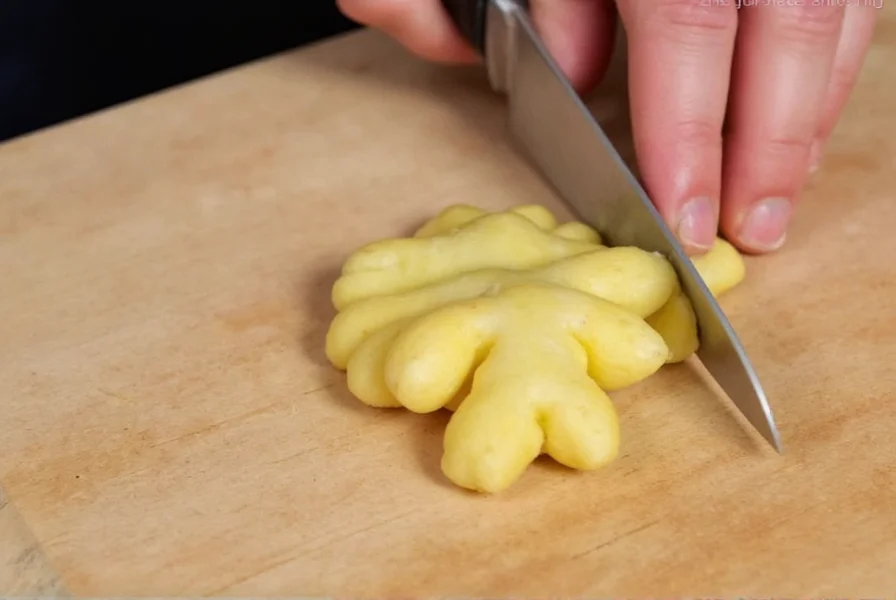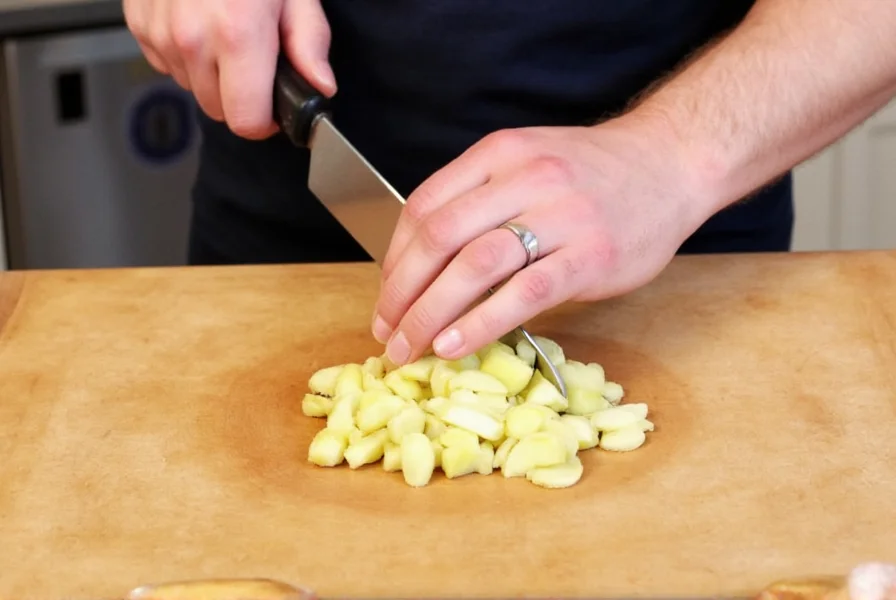Chopping ginger properly transforms both the texture and flavor profile of your dishes. Many home cooks struggle with this knobby root, either wasting precious material or ending up with uneven pieces that cook inconsistently. Understanding the proper technique makes a significant difference in your culinary results, whether you're preparing Asian stir-fries, baking ginger cookies, or making fresh ginger tea.
Essential Tools for Chopping Ginger
Before learning how to chop ginger effectively, gather these kitchen essentials:
| Tool | Why It Matters | Alternative |
|---|---|---|
| Sharp chef's knife (6-8 inches) | Clean cuts prevent bruising ginger fibers | Paring knife for small quantities |
| Stable cutting board | Prevents slipping during chopping | Place damp towel beneath board |
| Spoon (tablespoon) | Gentle peeling without waste | Vegetable peeler (removes more flesh) |
| Small bowl of water | Prevents ginger juice from irritating eyes | None - highly recommended |
Step-by-Step Guide to Chopping Ginger

1. Selecting and Preparing Your Ginger
Choose firm, smooth ginger with tight skin and no soft spots. Refrigerated ginger becomes harder to work with, so allow it to reach room temperature before chopping. This makes the root less brittle and easier to slice cleanly.
2. The Spoon Peeling Technique
Forget traditional peelers that remove too much valuable flesh. Instead, use the edge of a spoon to gently scrape away the papery skin. The concave shape follows ginger's contours perfectly, minimizing waste while removing all brown skin. This professional method for chopping ginger without wasting precious material preserves up to 30% more usable root compared to conventional peeling.
3. Slicing Against the Grain
Identify the fiber direction by looking at the striations on the ginger's surface. Always slice across these fibers rather than with them. Thin slices (⅛ inch) ensure even cooking and proper texture in your dishes. For stir-fries, slightly thicker slices (¼ inch) work better, while baking typically requires the thinnest possible cuts.
4. The Proper Dicing Motion
Stack several slices together, then cut lengthwise into matchsticks (julienne). Gather these sticks and rotate 90 degrees before dicing into uniform cubes. Keep your knife tip in contact with the cutting board throughout the motion for control and safety. This technique for finely chopping ginger root creates consistent pieces that cook evenly and release flavor uniformly.
Different Chopping Styles for Various Dishes
Understanding how to cut ginger for specific recipes elevates your cooking:
- Fine mince - For marinades and dressings where you want ginger flavor without texture
- Julienne - Perfect for stir-fries where you want visible ginger strands
- Thin coins - Ideal for tea, poaching, or slow cooking where you'll remove ginger later
- Rough chop - Best for stocks and broths where texture doesn't matter
Professional Tips for Better Ginger Preparation
Master these advanced ginger chopping methods to improve your kitchen efficiency:
- Freeze ginger root before chopping for firmer texture and cleaner cuts
- Dip knife blade in water between cuts to prevent sticky ginger residue buildup
- Use the side of your knife to smash ginger before mincing for maximum juice extraction
- Keep fingertips curled inward using the "claw grip" to prevent accidental cuts
- Chop near the cutting board's edge for better visibility of your knife work
Storing Chopped Ginger Properly
Proper storage extends ginger's shelf life significantly. Place chopped ginger in an airtight container with a paper towel to absorb excess moisture. Refrigerate for up to 2 weeks. For longer storage, freeze ginger pieces on a parchment-lined tray before transferring to freezer bags. Frozen ginger can be grated directly into dishes without thawing—a professional trick for maintaining ginger's volatile oils.
Common Mistakes to Avoid When Chopping Ginger
Even experienced cooks make these errors when preparing ginger:
- Using a dull knife that mashes rather than cuts the fibers
- Peeling with a vegetable peeler, removing too much usable flesh
- Cutting with the grain instead of against it, creating stringy pieces
- Working with cold ginger straight from the refrigerator
- Leaving ginger exposed to air, causing it to dry out and lose potency
Remember that properly chopped ginger should have clean edges without bruising. If your pieces look smashed or fibrous, adjust your technique—this indicates you're cutting with the grain or using insufficient knife sharpness.
FAQs About Chopping Ginger
What's the easiest way to peel ginger before chopping?
The spoon method is the easiest way to peel ginger without wasting material. Simply use the edge of a tablespoon to scrape away the thin skin. The spoon's curvature follows ginger's irregular shape perfectly, removing only the papery skin while preserving the valuable flesh beneath. This technique works especially well for knobby ginger pieces that challenge traditional peelers.
How fine should I chop ginger for stir-fry?
For stir-fry, chop ginger into thin matchsticks (julienne) about 1/16 inch thick. This size provides visible ginger pieces that cook evenly without burning. If using in a sauce or marinade where you don't want noticeable ginger pieces, mince it more finely. The proper ginger chopping methods for Asian cuisine typically involve slightly larger pieces than Western recipes to maintain texture contrast in the finished dish.
Can I use a food processor to chop ginger?
While possible, food processors often create uneven ginger pieces and can over-process the fibrous root into a paste. For most cooking applications, hand-chopping produces superior results with better texture control. If using a processor, pulse in very short bursts and check frequently. The best way to chop fresh ginger for precise recipes remains the traditional knife method, which gives you complete control over the final texture.
Why does my ginger stick to the knife when I chop it?
Ginger contains natural oils that make it sticky. To prevent this, dip your knife blade in cold water between cuts. The water creates a barrier between the blade and ginger fibers. Alternatively, lightly oil your knife blade before chopping. This professional technique for chopping ginger without sticking ensures clean cuts and prevents wasted material adhering to your knife.
How can I chop ginger safely with small hands?
For smaller hands, use the "claw grip" technique: curl fingertips inward while keeping knuckles against the knife blade for guidance. Start with smaller ginger pieces that are easier to control. Consider using a smaller knife (5-6 inch) that better matches your hand size. Always keep the cutting board stable—place a damp towel beneath it. Proper knife skills for ginger preparation emphasize safety through technique rather than force, making it manageable for all hand sizes.











 浙公网安备
33010002000092号
浙公网安备
33010002000092号 浙B2-20120091-4
浙B2-20120091-4